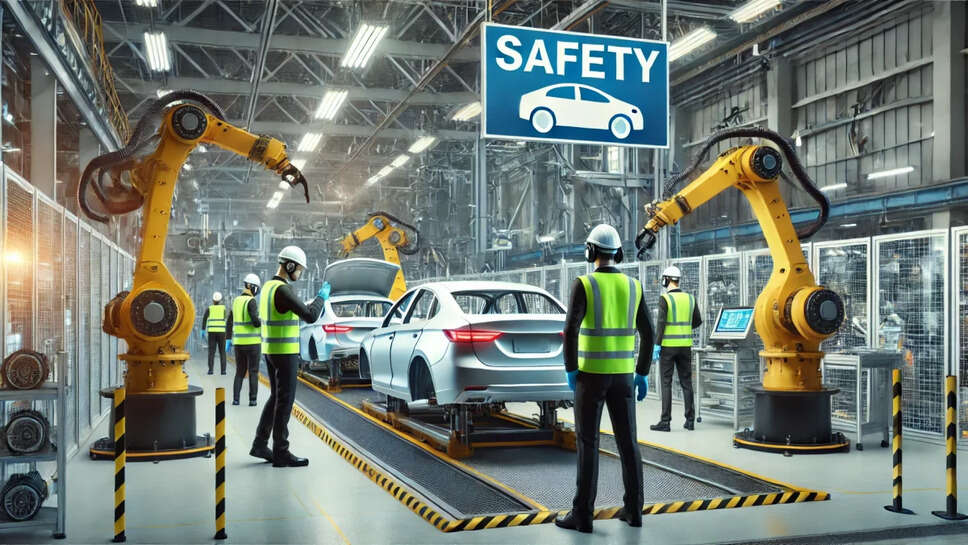Automotive Industry Sees Alarming 35% Rise in Worker Injuries

A recent report by the ‘Safe in India Foundation’ has revealed a troubling surge in workplace injuries within India’s automotive manufacturing sector. According to the findings, worker injuries have risen by a staggering 35% year-on-year, highlighting a growing safety crisis on the factory floors of one of India’s largest and most critical industries.
The report, which draws from data across major automobile manufacturing clusters like Gurugram-Manesar, Faridabad, and Pune, paints a grim picture of the occupational hazards faced by thousands of shop-floor workers — many of whom are employed under contract and lack adequate protections or medical coverage.
A Surging Safety Concern
The automotive industry is often hailed as a symbol of India’s industrial prowess. It contributes over 7% to India’s GDP and employs over 37 million people directly and indirectly. Yet behind the gleaming machines and global exports lies an often-invisible human cost.
The report by Safe in India Foundation, a non-profit that has been working with injured workers and advocating for safer practices since 2016, shows that in just one year, recorded injuries have jumped 35%. The vast majority of these injuries involve amputations of fingers, hands, or limbs — often due to mishandling or malfunctioning of power presses and other heavy machinery.
Such injuries don’t just destroy livelihoods — they often plunge entire families into financial distress, especially when the affected worker is the sole breadwinner.
Contractual Labour at Highest Risk
One of the most concerning aspects highlighted by the report is the vulnerability of contract workers, who make up a significant proportion of the automotive workforce — nearly 70% in some plants.
These workers are often poorly trained, inadequately supervised, and given little to no say in safety-related decisions. Most lack the protection of strong labor unions and are less likely to report unsafe working conditions due to fear of job loss.
While permanent employees often benefit from structured training and safety protocols, contract workers are frequently left to learn on the job — a system that dramatically increases their risk of injury.
The report outlines that contract workers account for over 80% of reported injuries in the auto manufacturing ecosystem.
Major Safety Violations and Poor Regulation
The report sheds light on repeated safety lapses and regulatory negligence. Common issues include:
-
Malfunctioning Machines: Many workers reported being forced to operate machines with broken or missing safety guards.
-
Lack of Emergency Protocols: Several injured workers said there were no proper procedures in place for medical emergencies.
-
Negligent Maintenance: Delays in servicing machines lead to unexpected malfunctions, causing serious injuries.
-
Inadequate Training: New and young workers are often put on dangerous equipment with minimal instruction.
Perhaps most alarming is the apparent absence of deterrence — many of these injuries are not reported to labor departments or insurance agencies, allowing factory owners and contractors to avoid accountability.
Women Workers and the Silent Cost
While men dominate the heavy machinery workforce, the report also draws attention to the rising number of injuries among women workers, especially in ancillary roles such as packaging, inspection, and assembly-line processes.
The psychological toll on injured workers, regardless of gender, is profound. Many face long-term disability, depression, social stigma, and severe financial strain. Safe in India estimates that nearly 25% of injured workers they assist are unable to return to full-time employment even a year after their incident.
Insurance and ESIC: A System Under Stress
India’s Employee State Insurance Corporation (ESIC) is designed to support injured workers. However, Safe in India’s field interviews show that navigating the ESIC system is often a nightmare for victims.
Injured workers frequently struggle to access compensation, disability pensions, or proper rehabilitation. Many are unaware of their rights or lack the documents needed to file claims. Hospitals under the ESIC system are overburdened, understaffed, or ill-equipped to handle industrial trauma cases.
The report calls for urgent reforms in the ESIC system, including better grievance redressal, digital tracking of claims, and stronger partnerships with NGOs to facilitate awareness.
Industry Responsibility and the Role of OEMs
Original Equipment Manufacturers (OEMs) — major car and bike companies — bear significant responsibility, even if injuries occur in their supplier factories.
The report pushes OEMs to:
-
Audit their entire supply chains for safety compliance.
-
Ensure that vendors and sub-contractors follow standardized safety protocols.
-
Provide training resources and emergency health support.
-
Introduce technology-based monitoring to prevent future injuries.
While some OEMs have taken steps toward more responsible supplier relationships, industry-wide adoption of robust safety standards remains lacking.
Policy Recommendations
The report does not merely present grim statistics; it also lays out a roadmap to reverse the trend:
-
Stronger Enforcement of Labour Laws: Labour inspectors must be empowered, and factories should face real penalties for safety violations.
-
Standardized Training Modules: Mandated pre-employment training for all workers, especially those handling machines.
-
Mandatory Machine Safeguards: Regular third-party audits to ensure machinery meets safety norms.
-
Digital Record-Keeping: Use of digital tools for reporting, tracking, and monitoring workplace injuries.
-
Better Medical Care Access: Improved infrastructure for ESIC hospitals and rehabilitation services.
A Wake-Up Call for Industrial India
The automotive industry prides itself on efficiency, automation, and global competitiveness. But as the report shows, these metrics mean little if they come at the cost of human safety.
Industrial growth without safety is unsustainable. As India aims to become a global manufacturing hub under initiatives like 'Make in India' and 'Atmanirbhar Bharat', protecting the very workers who fuel that ambition is non-negotiable.
The 35% increase in injuries should be a wake-up call — not just for factory owners, but for policymakers, OEMs, and the broader business ecosystem.
Workers are not just cogs in a machine; they are the pulse of the economy. Ensuring their safety is not an expense — it’s an investment in a just, productive, and humane future.
